Lenovo Yoga C930 review – a premium 2-in-1 companion
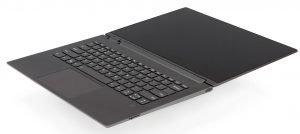 Lately, we have been making reviews about budget or gaming notebooks (and sometimes budget gaming notebooks) so here is something fresh. We are going to take an in-depth look at the Lenovo Yoga C930 – a top-end 14-inch 2-in-1 convertible.
Lately, we have been making reviews about budget or gaming notebooks (and sometimes budget gaming notebooks) so here is something fresh. We are going to take an in-depth look at the Lenovo Yoga C930 – a top-end 14-inch 2-in-1 convertible.
Apart from the beautiful looks and sturdy build quality, the Lenovo Yoga C930 catches the eye with a few unique design choices. For instance, the speakers aren’t located on the front or back of the notebook, instead, they are enclosed inside the 360 degrees hinge. The Rotating Sound Bar, as Lenovo calls it, features Dolby Atmos speakers for more immersive sound. woofers.
The digital stylus which comes with the notebook and has its own compartment and the camera features a “Privacy Shutter”. We will talk more about these features below.
You can check the prices and configurations in our Specs System: https://laptopmedia.com/series/lenovo-yoga-c930/
Contents
Specs Sheet
Lenovo Yoga C930 technical specifications table
What’s in the box?
The unboxing experience that the Yoga C930 has to offer is not like any other. You get a colorful box that has two magnetically attached lids which open up like an actual cardboard box. Opening the lids lifts the internal casing a bit. There you have your notebook and below it, inside drawers, you can find the charger and manuals.
Design and construction
Starting with the design, the Yoga C930 got the looks. The notebook immediately strikes as a premium device with its matte graphite finish and aluminum unibody design. The edges are polished and reflect light; there is also a noticeable dispersion effect.
Build quality is very good. The lid can be slightly bent if you really push into it but even so, it’s hardly noticeable. Same goes for the back plate. There are two rubber stripes, however, they don’t do a good job at keeping the laptop in place. There are also two backfiring woofers but the main speakers are inside the hinge. The two small rectangles on both sides are the antennas.
Speaking on the hinge, it’s made out of metal and it feels sturdy. Unfortunately, opening the lid requires both hands. One of the unique features of the Yoga C930 is the Dolby Atmos speakers which are located inside the so-called Rotating Sound Bar or as we called it – the hinge. We will cover the sound quality further down in the review. The only vent is hidden behind the hinge.
Opening the notebook reveals the 14-inch touchscreen. It has fairly thin bezels and a large chin – something common these days. Above the screen, you can find the ambient light sensor and the webcam with a TrueBlock Privacy Shutter. You may ask what this means – it’s a cover which blocks the lens so you can rest calmly knowing your camera does not see you. There is a slider above the camera to remove the cover. With this feature, you can forget about your tin foil fat.
The keyboard of the Yoga C930 has the Lenovo AccuType look with a rounded bottom side of each key, however, there is no inward slope like ThinkPads do – the keys are flat. It has a two-level white illumination. Of course, the keyboard is smaller than what you’ll find on a 15.6-inch notebook so getting used to the layout might take some time. However, the keys have a good amount of feedback and travel. Overall, a good keyboard but we think it could have been better. The touchpad is excellent.
There is a fingerprint reader below the bottom right corner of the keyboard. It’s very accurate and it can recognize your finger even if you place it at an angle but it takes a second to process – you can’t just tap on it.
Ports
The Lenovo Yoga C930 has an extremely limited port selection. All the ports are located on the left-hand side. There you can find a single USB 3.1 port, two USB Type-C ports both of which support Thunderbolt 3, and a 3.5 mm headphone jack.
It’s a bit uncomfortable to see that there is just one regular USB and no HDMI even but then again you can connect virtually anything to the Thunderbolt ports. One of them doubles as a charging port too.
On the other side, you can find the power button. The back is where the stylus is. It is inserted into the notebook. You have to push it until you hear a click then release and it pops up. After finishing using it just slide it back in. The Stylus gets charged inside the compartment. It’s comfortable to use and accurate. It has two buttons which can do different things depending on the app.
Disassembly, upgrade options and maintenance
Removing the back lid is easy. You have to remove X Phillips screws and then pry it open. It comes off easy but be careful with the (plastic) teeth.
Once you open the notebook, you immediately notice that there are two fans connected via a single pipe. You would typically see a single fan cooling system on such thin notebooks. The other thing you see is the large (for the laptop’s size) 60Wh battery with a model number L17M4PH1. There are no RAM slots – all the available RAM in soldered to the board.
On the left side, you see the single M.2 slot which is the only storage interface on the Lenovo Yoga C930. It supports PCIe NVMe 3.0 x4 SSD with up to 1TB capacity. On the other side is located the M.2 Wi-Fi card – Intel 9260NGW.
The image below shows you the pen compartment and its spring-loaded mechanism.
Display quality
The Lenovo Yoga C930 offers a Full HD touchscreen IPS display – AUO B139HAN03.0. Its diagonal size is 14.0 inches (35.56 cm) though sometimes advertised as 13.9”. The screen ratio is 16:9 and the resolution is 1920 x 1080p which translates into a pixel density of 157 PPI. The pixel pitch is – 0.161 х 0.161 mm. The screen can be considered Retina when viewed from further than 22 inches (55 cm). From this distance, the individual pixels become indistinguishable for the average human eye.
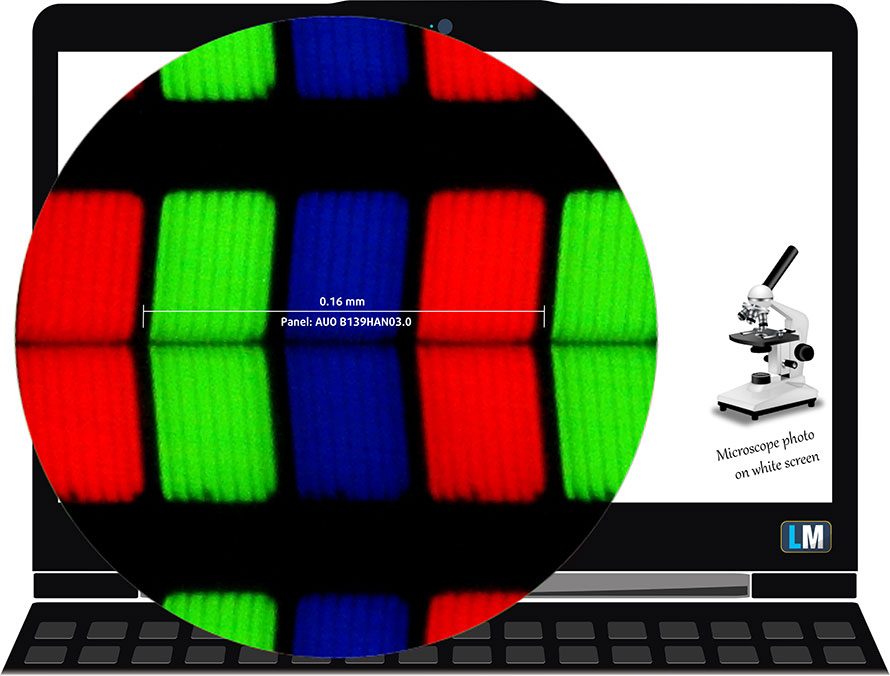
Viewing angles are excellent. We offer images at 45° to evaluate the quality.
The maximum measured brightness is 318 nits (cd/m2) in the middle of the screen and 298 nits (cd/m2) average across the surface with a maximum deviation of 16% in the bottom left corner. The Correlated Color Temperature on a white screen and at maximum brightness is 6690K (average) –almost in line with the optimal 6504K temperature for sRGB. The average color temperature through the grey scale before profiling is 6600K.
In the illustration below you can see how the display performs from uniformity perspective. In other words the leakage of light from the light source. The illustration below shows how matters are for operational brightness levels (approximately 140 nits) – in this particular case at 80% Brightness (White level = 137 cd/m2, Black level = 0.15 cd/m2).
Values of dE2000 over 4.0 should not occur, and this parameter is one of the first you should check if you intend to use the laptop for color sensitive work (a maximum tolerance of 2.0 ). The contrast ratio is good – 920:1 (720:1 after profiling).
Color reproduction
To make sure we are on the same page, we would like to give you a little introduction of the sRGB color gamut and the Adobe RGB. To start, there’s the CIE 1976 Uniform Chromaticity Diagram that represents the visible specter of colors by the human eye, giving you a better perception of the color gamut coverage and the color accuracy.
Inside the black triangle, you will see the standard color gamut (sRGB) that is being used by millions of people in HDTV and on the web. As for the Adobe RGB, this is used in professional cameras, monitors etc for printing. Basically, colors inside the black triangle are used by everyone and this is the essential part of the color quality and color accuracy of a mainstream notebook.
Still, we’ve included other color spaces like the famous DCI-P3 standard used by movie studios, as well as the digital UHD Rec.2020 standard. Rec.2020, however, is still a thing of the future and it’s difficult for today’s displays to cover that well. We’ve also included the so-called Michael Pointer gamut, or Pointer’s gamut, which represents the colors that naturally occur around us every day.
The yellow dotted line shows Lenovo Yoga C930’s color gamut coverage.
Its display covers 93% of the sRGB/ITU-R BT.709 (web/HDTV standard) in CIE1976.
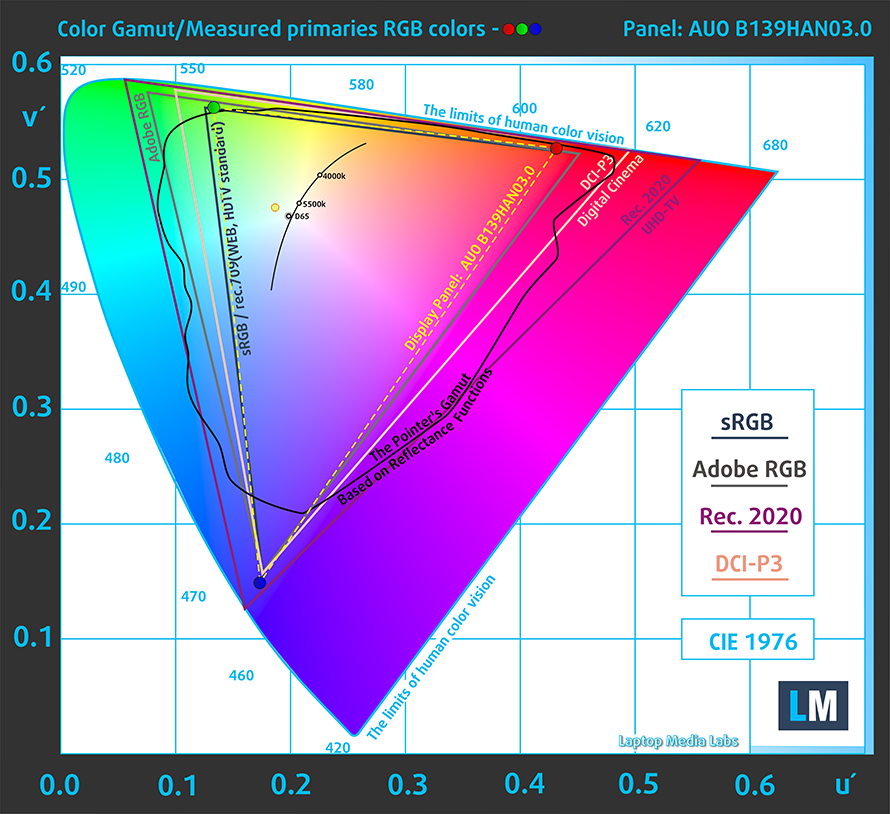
Our “Design and Gaming” profile delivers optimal color temperature (6500K) at 140 cd/m2 luminance and sRGB gamma mode.
We tested the accuracy of the display with 24 commonly used colors like light and dark human skin, blue sky, green grass, orange etc. You can check out the results at factory condition and also, with the “Design and Gaming” profile.
Below you can compare the scores of Lenovo Yoga C930 with the default settings (left), and with the “Gaming and Web design” profile (right).
The next figure shows how well the display is able to reproduce really dark parts of an image, which is essential when watching movies or playing games in low ambient light.
The left side of the image represents the display with stock settings, while the right one is with the “Gaming and Web Design” profile activated. On the horizontal axis, you will find the grayscale and on the vertical axis – the luminance of the display. On the two graphs below you can easily check for yourself how your display handles the darkest nuances but keep in mind that this also depends on the settings of your current display, the calibration, the viewing angle and the surrounding light conditions.
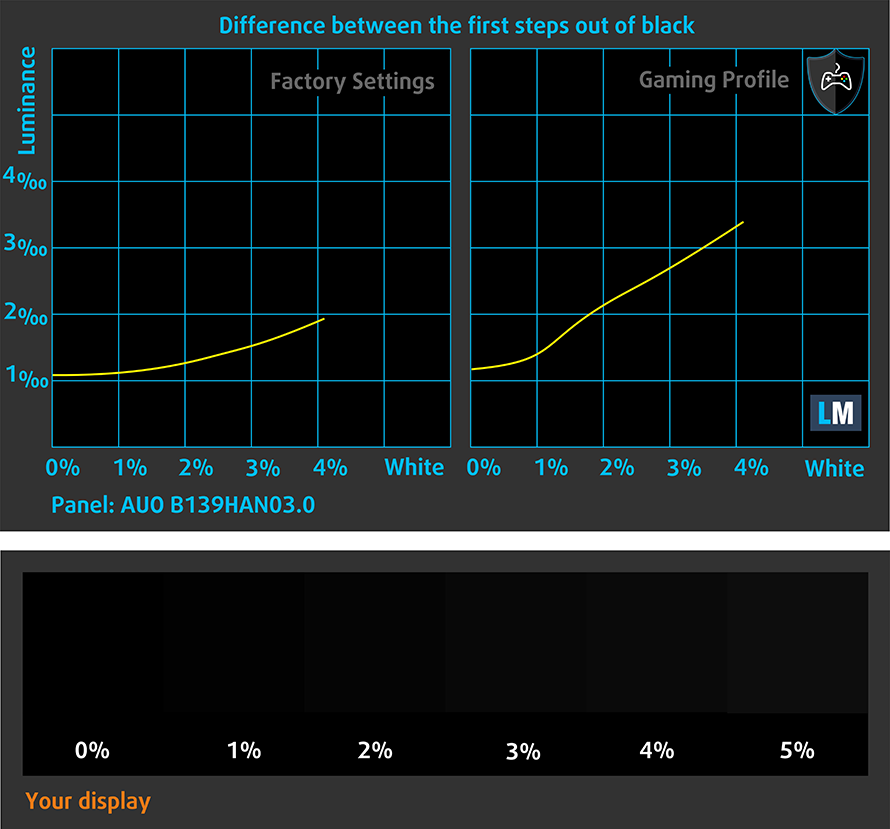
Response time (Gaming capabilities)
We test the reaction time of the pixels with the usual “black-to-white” and “white-to-black” method from 10% to 90% and vice versa.
We recorded Fall Time + Rise Time = 28 ms.
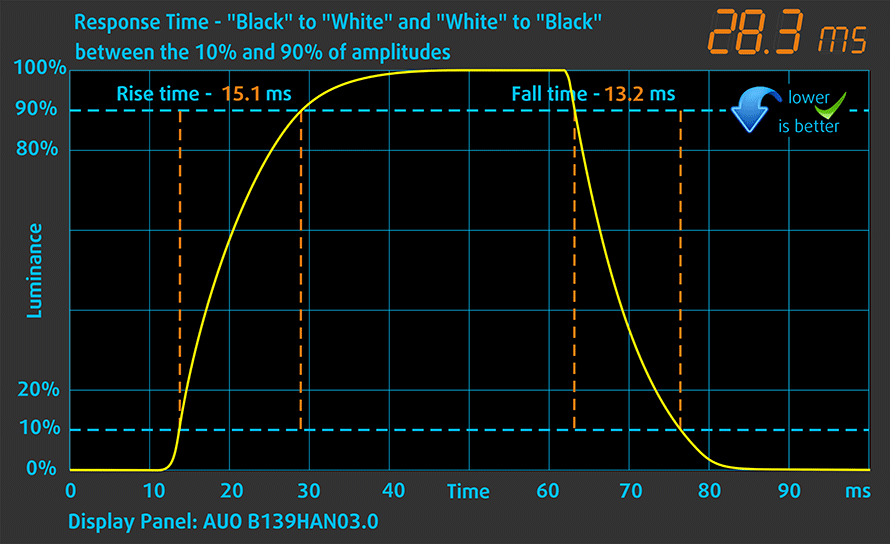
PWM (Screen flickering)
Pulse-width modulation (PWM) is an easy way to control monitor brightness. When you lower the brightness, the light intensity of the backlight is not lowered, but instead turned off and on by the electronics with a frequency indistinguishable to the human eye. In these light impulses, the light/no-light time ratio varies, while brightness remains unchanged, which is harmful to your eyes. You can read more about that in our dedicated article on PWM.
The backlight of the Lenovo Yoga C930 is not pulse-width modulated for all the levels of brightness which makes the display comfortable in the given aspect.
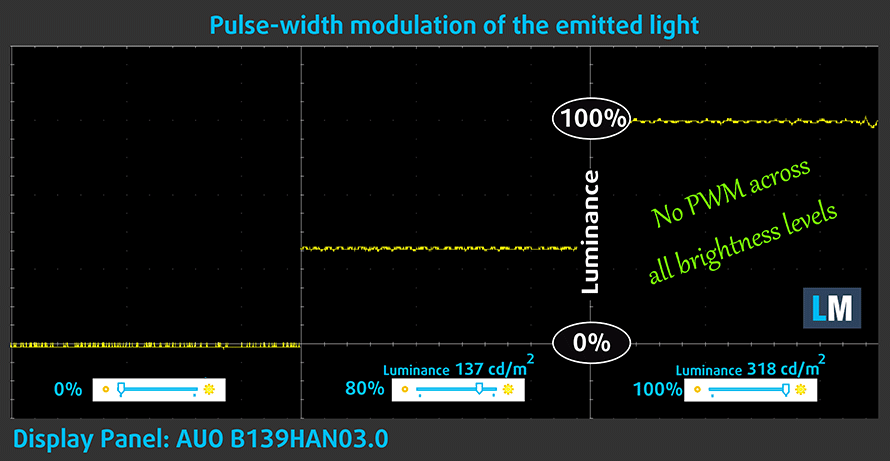
Blue light emissions
Installing our Health-Guard profile not only eliminates PWM but also reduces the harmful Blue Light emissions while keeping the colors of the screen perceptually accurate. If you’re not familiar with the Blue light, the TL;DR version is – emissions that negatively affect your eyes, skin and your whole body. You can find more information about that in our dedicated article on Blue Light.
You can see the levels of emitted blue light on the spectral power distribution (SPD) graph.
Conclusion
The display of the Lenovo Yoga C930 is touch sensitive which adds to the experience. It has a Full HD resolution and comfortable viewing angles. The maximum brightness can be considered high especially when operated in an indoor environment but due to the glossy finish, it might turn out insufficient in direct sunlight. The backlight is not pulse-width modulated and the color range is wide enough. The contrast ratio is good but could have been better for the price.
Buy our profiles
Since our profiles are tailored for each individual display model, this article and its respective profile package are meant for Lenovo Yoga C930 configurations with 14.0″ AUO B139HAN03.0 (FHD, 1920 × 1080) IPS.
*Should you have problems with downloading the purchased file, try using a different browser to open the link you’ll receive via e-mail. If the download target is a .php file instead of an archive, change the file extension to .zip or contact us at [email protected].
Read more about the profiles HERE.
In addition to receiving efficient and health-friendly profiles, by buying LaptopMedia's products you also support the development of our labs, where we test devices in order to produce the most objective reviews possible.

Office Work
Office Work should be used mostly by users who spend most of the time looking at pieces of text, tables or just surfing. This profile aims to deliver better distinctness and clarity by keeping a flat gamma curve (2.20), native color temperature and perceptually accurate colors.

Design and Gaming
This profile is aimed at designers who work with colors professionally, and for games and movies as well. Design and Gaming takes display panels to their limits, making them as accurate as possible in the sRGB IEC61966-2-1 standard for Web and HDTV, at white point D65.

Health-Guard
Health-Guard eliminates the harmful Pulse-Width Modulation (PWM) and reduces the negative Blue Light which affects our eyes and body. Since it’s custom tailored for every panel, it manages to keep the colors perceptually accurate. Health-Guard simulates paper so the pressure on the eyes is greatly reduced.
Get all 3 profiles with 33% discount
Sound
The sound which the Lenovo Yoga C930’s speakers provide is clear. The maximum volume is high the frequencys are clear without distortion.
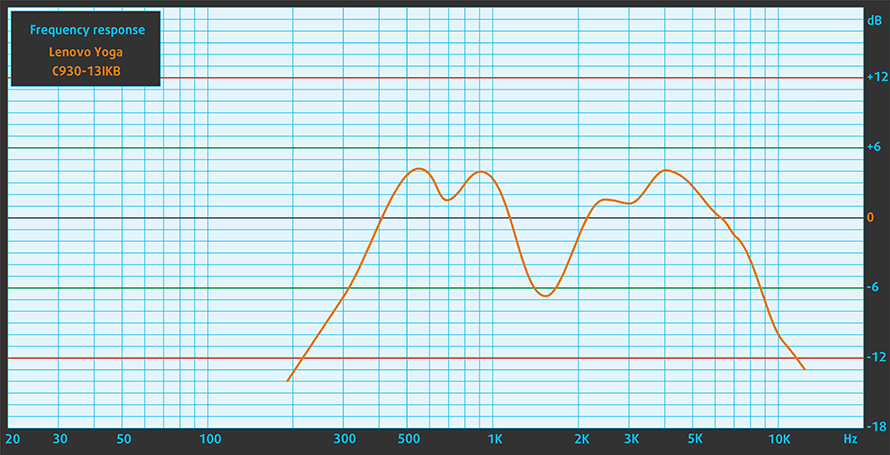
Drivers
You can find all the necessary drivers for Windows 10 on Lenovo’s support web page: https://pcsupport.lenovo.com/bg/en/products/laptops-and-netbooks/yoga-series/yoga-c930-13ikb/downloads
Battery
The Lenovo Yoga C930 is powered by a 60Wh battery (model number L17M4PH1) which is rather large for such a compact device. The large battery combined with the low-powered hardware, and probably a lot of effort from Lenovo, manages to keep the notebook running for quite some time. You can get more than 11 hours of battery life which is very rare.
Now, we conduct the battery tests with Windows Better performance setting turned on, screen brightness adjusted to 120 nits and all other programs turned off except for the one we are testing the notebook with.
In order to simulate real-life conditions, we used our own script for automatic web browsing through over 70 websites.
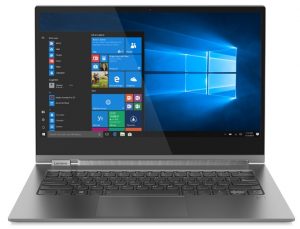
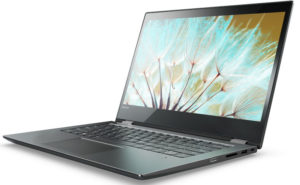
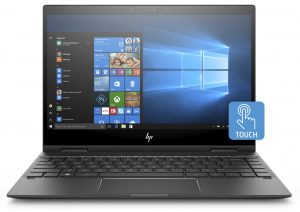
For every test like this, we use the same video in HD.



We use F1 2017’s built-in benchmark on loop in order to simulate real-life gaming.



Storage performance
Our configuration of the Yoga C930 was equipped with a 256 GB PCIe NVMe SSD by SK Hynix with a model number HFS256GD9TNG-62A0A.
You can opt for up to a 1TB PCIe SSD.
| SSD model (240-256GB variants) | Max.Seq.Read (GB/s) | Max.Seq.Write (GB/s) | IOPS 4K Read | IOPS 4K Write | Latency Read (ms) | Latency Write (ms) |
| SK Hynix HFS256GD9TNG | 2.63 | 0.82 | 9363 | 20733 | 0.037 | 0.050 |
| Intel SSD 760p / PEKKW256G8L (NVMe) | 2.35 | 1.03 | 13340 | 24671 | 0.047 | 0.048 |
| Samsung SM951 (NVMe) | 2.24 | 1.29 | 11320 | 28450 | 0.057 | 0.034 |
| Samsung PM951 MZVLV2560 (NVMe) | 1.58 | 0.31 | 0.121 | 0.035 | ||
| SK Hynix SC300 (NVMe) | 3.19 | 0.91 | 11000 | 26180 | 0.060 | 0.053 |
CrystalDiskMark – Max.Seq.Read/Write; AS SSD – IOPS 4K Read/Write, Latency Read/Write
CPU options
The Lenovo Yoga C930 is powered by an 8th gen Intel ULV chip. You can opt for either the Core i5-8250U or the Core i7-8550U. Our particular model features the first one.
Check out it Top Laptop CPU Ranking: https://laptopmedia.com/top-laptop-cpu-ranking/
Results are from the Cinebench 20 CPU test (the higher the score, the better)
Results are from our Photoshop benchmark test (the lower the score, the better)
Results are from the Fritz chess benchmark (the higher the score, the better)
GPU options
There are no options for a dedicated GPU. The only graphics card available is the integrated Intel UHD Graphics 620 which is perfect for consuming multimedia but nothing more intensive.
Check out it Top Laptop Graphics Ranking: https://laptopmedia.com/top-laptop-graphics-ranking/
Results are from the 3DMark: Fire Strike (Graphics) benchmark (higher the score, the better)
Results are from the Unigine Superposition benchmark (higher the score, the better)
Gaming tests
The Lenovo Yoga C930 might be versatile but one thing it’s not meant for is gaming. You shouldn’t expect good frame rates in modern 3D games.

| Grand Theft Auto V (GTA 5) | HD, Normal (Check settings) | HD, High (Check settings) | HD, Very High (Check settings) |
|---|---|---|---|
| Average FPS | 24 fps | 9 fps | – fps |
Temperatures and comfort
Max CPU load
In this test we use 100% on the CPU cores, monitoring their frequencies and chip temperature. The first column shows a computer’s reaction to a short load (2-10 seconds), the second column simulates a serious task (between 15 and 30 seconds), and the third column is a good indicator of how good the laptop is for long loads such as video rendering.
Average core temperature (base frequency + X); CPU temp.
| Intel Core i5-8250U (15W TDP) | 0:02 – 0:10 sec | 0:15 – 0:30 sec | 10:00 – 15:00 min |
|---|---|---|---|
| Lenovo Yoga C930 | 2.91 GHz (B+82%)@ 91°C | 2.72 GHz (B+70%)@ 95°C | 2.42 GHz (B+51%)@ 85°C |
| Dell Vostro 14 5471 | 3.12 GHz (B+95%)@ 76°C | 2.61 GHz (B+63%)@ 77°C | 2.22 GHz (B+39%)@ 64°C |
The cooling system of the Yoga C930 could definitely be better. The temperature of the CPU when loaded reaches dangerous values of around 90-95°C which is just a few degrees below the maximum allowed. Despite the high temperature, the notebook is stable.
You can see that we have compared it to the Dell Vostro 14 5471 which we recently reviewed. The Vostro 14 5471 run on the same processor and has roughly the same size (14 vs 13.9 inches) like the Yoga C930 but it handles the stress test a lot better. Of course, the Vostro 14 5471 is not a 2-in-1 notebook and it’s also thicker which helps with air flow and the design on the cooling system.
You will probably not stress the notebook for long periods of time because it’s not suited to run heavy applications so you shouldn’t worry about overheating.
Gaming comfort
The surface temperatures are rather low considering the high internal ones. The hottest areas (in white) reach around 45°C which is just about average on what we’ve seen. The palm rest area is a lot cooler (pink to purple colors).
Verdict

Overall, the Lenovo Yoga C930 leaves a pleasant impression in our minds. It has all the good you could expect from a 2-in-1 notebook. The screen is one of the most important features of any notebook but when it comes to a 2-in-1 – it’s even more relevant as you will presumably use it as a tablet from time to time. The Yoga C930 got this covered – the 14-inch touchscreen (AUO B139HAN03.0) offers thin bezels, good contrast and viewing angles, high gamut coverage (93% sRGB in CIE1976), and no PWM. The maximum brightness is high, however, there is a glossy finish which reflects light from ambient sources. The factory settings are fine but our custom-tailored profiles just add to the experience by reducing the average dE (color accuracy) to just 1.1.
The built-in pen adds functionalities. It’s easy to use and charges when it’s inside the dedicated compartment. The ports selection on the Yoga C930 is a hit and miss. On one hand, you have no HMDI and only one USB 3.0 port but on the other – two USB Type-C Thunderbolt 3 ports get things covered.
Lenovo has managed to place a fairly large 60Wh battery which provides battery life which we all dream of. However, there isn’t any room left inside the notebook. The RAM is soldered and you get only one M.2 slot for storage. The cooling system has also suffered from this miniaturization – the notebook is stable but the internals gets hot when loaded.
This notebook offers a lot but is definitely not for everyone. Its premium features come at a fairly premium price. If you want a versatile laptop with premium build quality, great battery life, and performance is not essential for you then the Lenovo Yoga C930 is what you are looking for.
If the Yoga C930 is not the perfect convertible for you, perhaps you can find better the Dell Inspiron 5379 or the Microsoft Surface Book 2. You can also take a look at the HP ProBook x360 440 G1.
You can check the prices and configurations in our Specs System: https://laptopmedia.com/series/lenovo-yoga-c930/
Pros
- Excellent battery life
- Two USB Type-C ports with Thunderbolt 3 support
- Wide color range (AUO B139HAN03.0)
- Built-in stylus
Cons
- Limited upgrade options
- Not the ideal cooling system

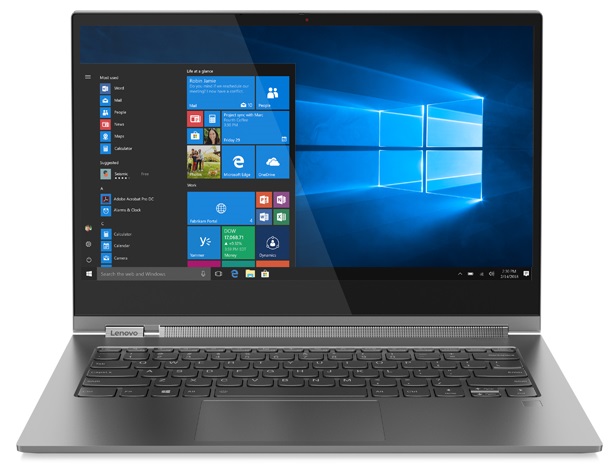

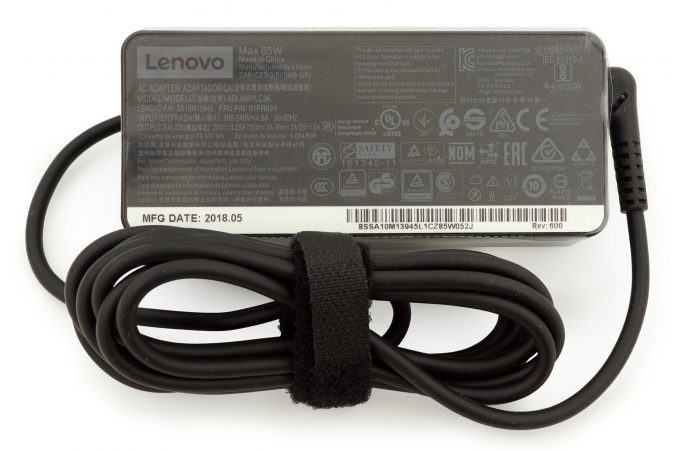
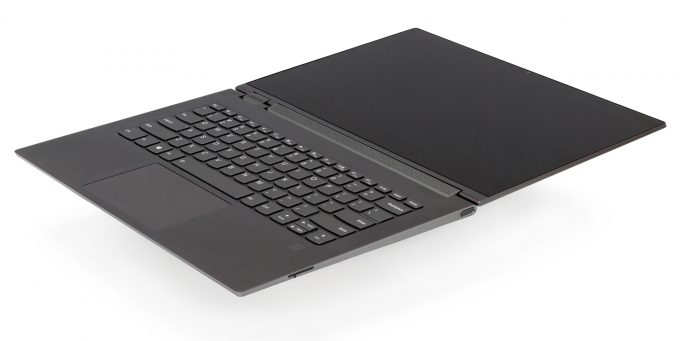
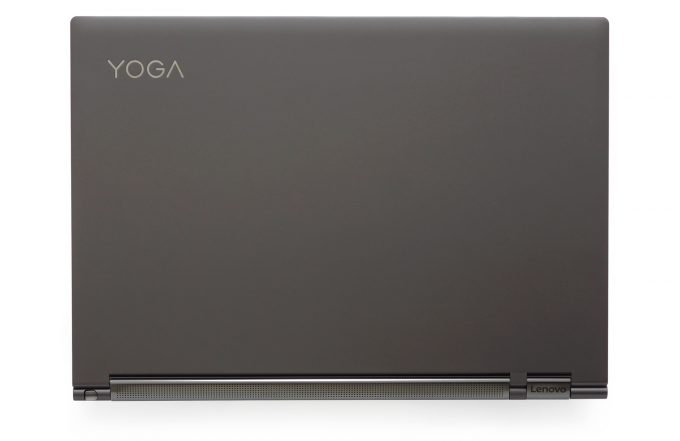
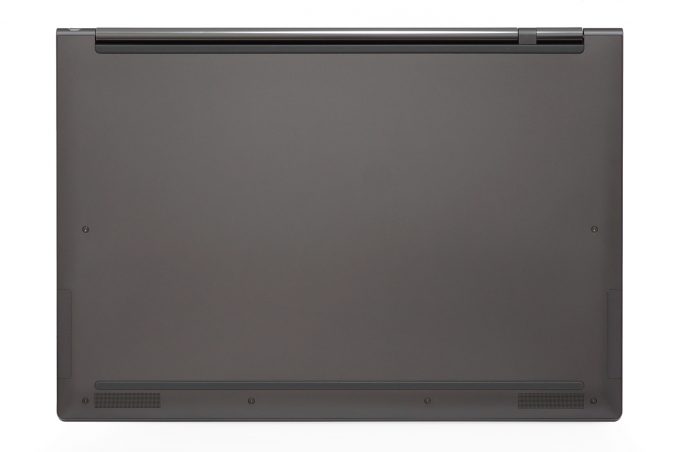
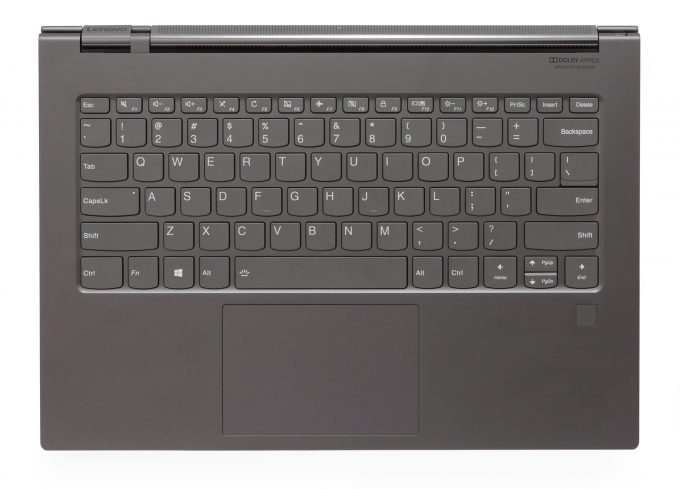
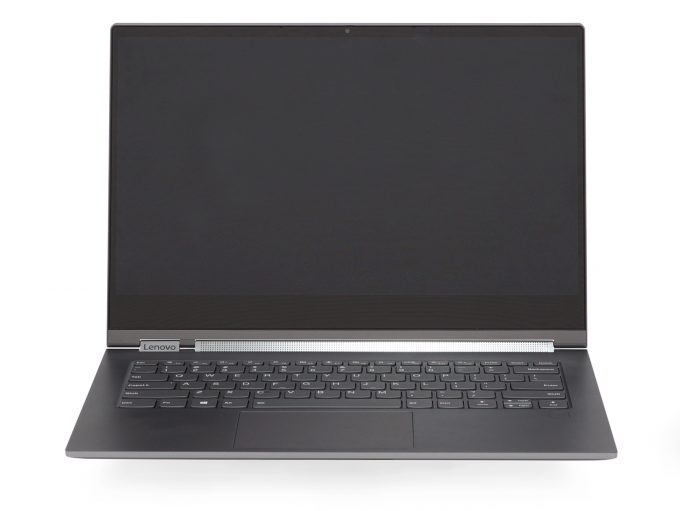
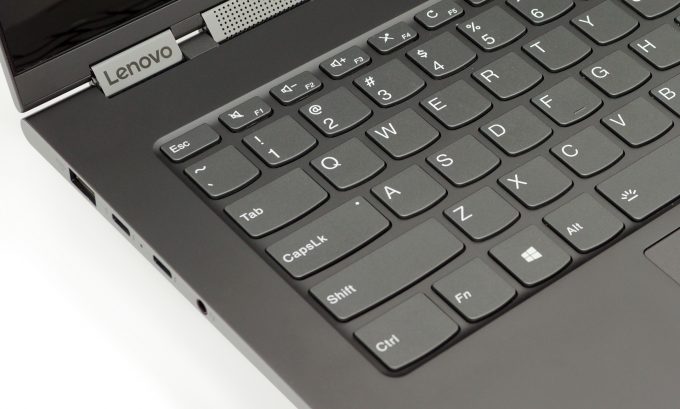


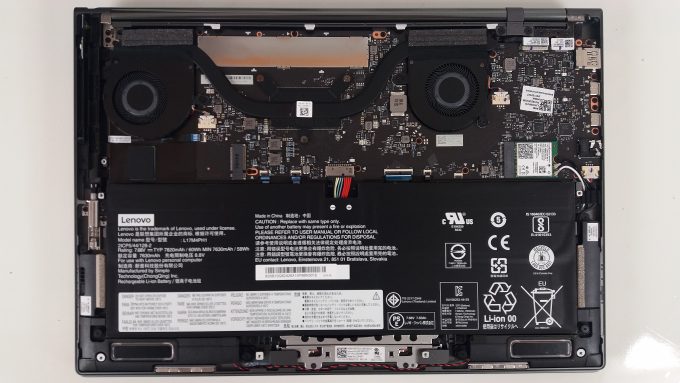


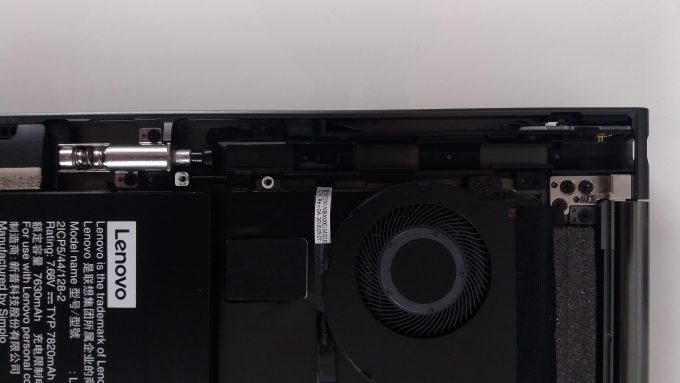

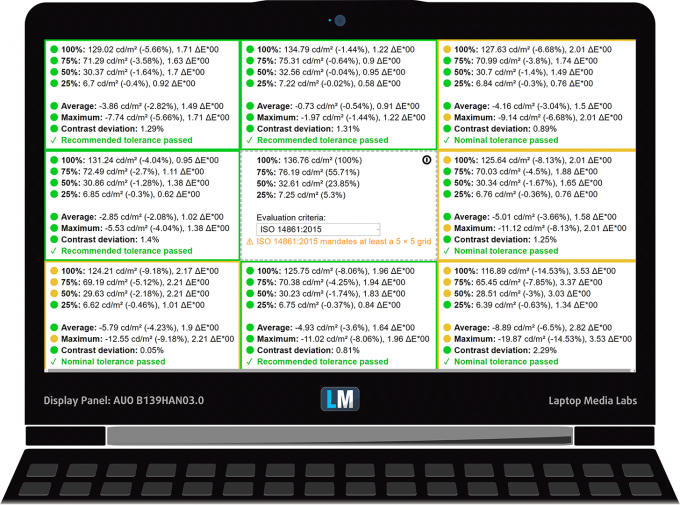
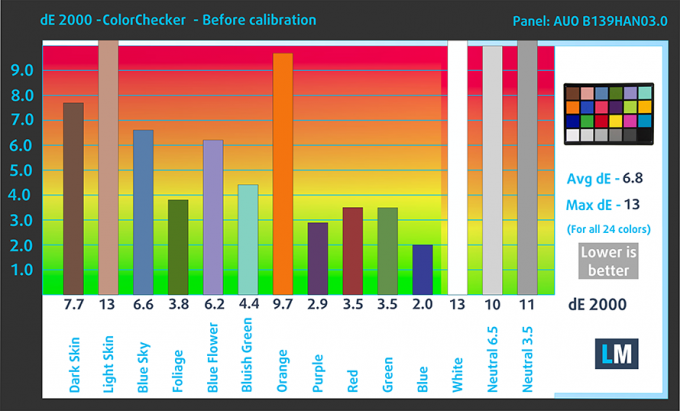
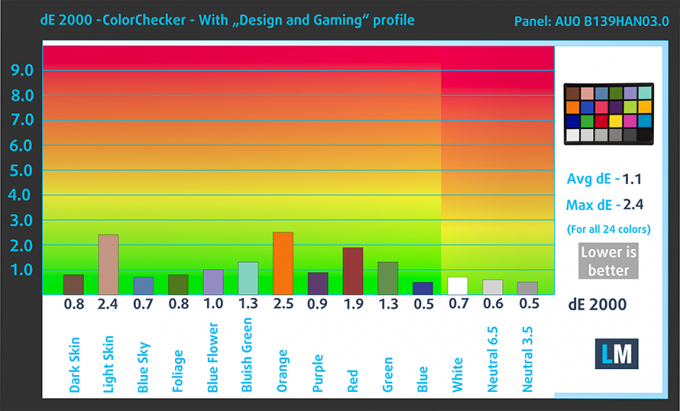

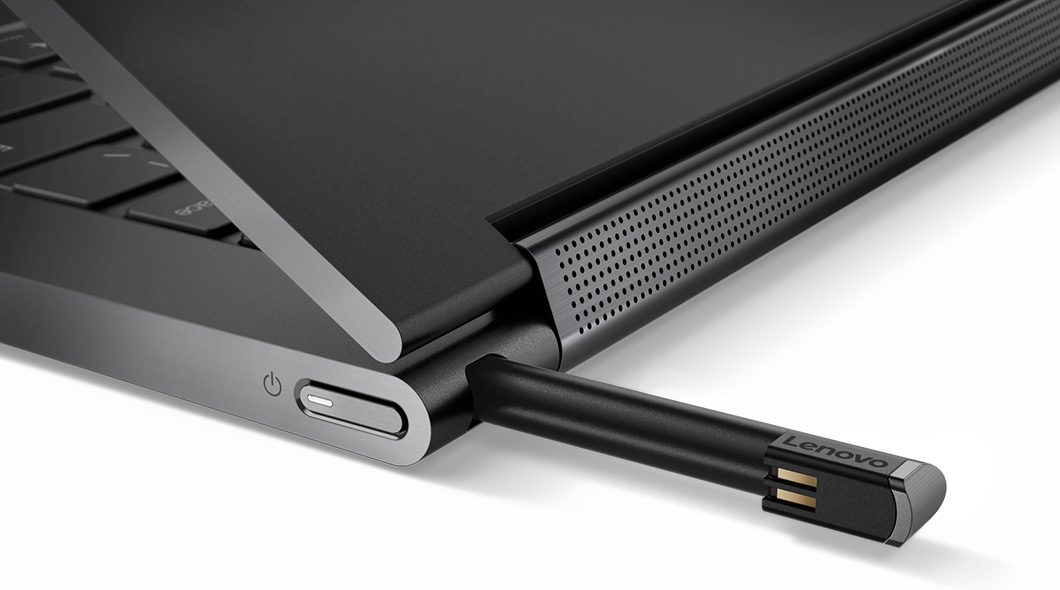

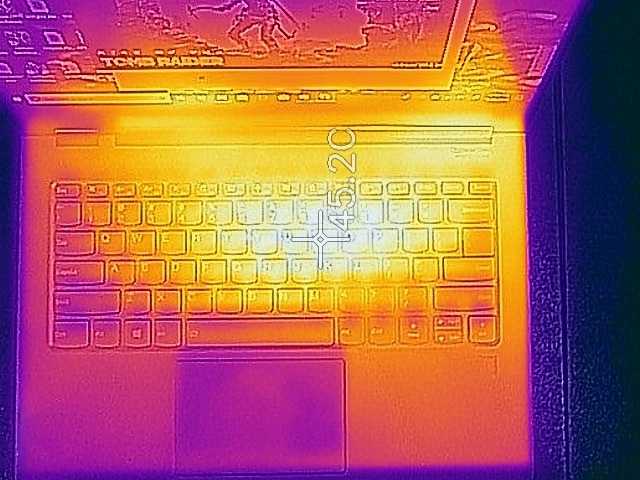








Hey guys, first of all I’d like to thank you for this profound review. It seems as if the dE was the C930’s bottleneck. Accordig to your test, dE can be improved by using your ‘Design and Gaming” profile. Does this profile come at a cost of display brightness? A fact that would make it even less useful outdoors. If the ‘Desing and Gaming’ profile affects brightness, to which level does the C930’s reduce when the profile is activated?
Looking forward to hearing from you, Carl